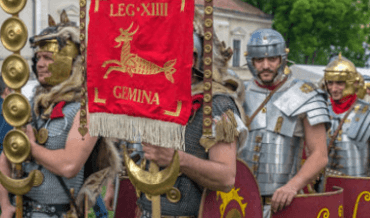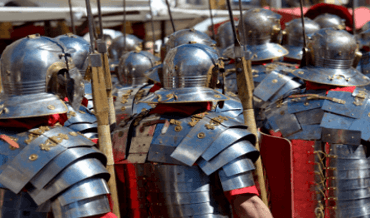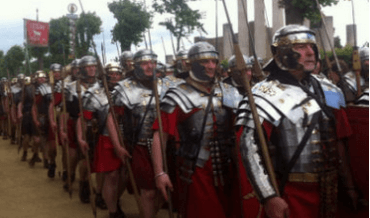Roman Legionary Decorations
The Roman Legion, like most organized armies throughout history, had a very distinguished awards system. Decorations were usually worn by the soldiers on parades, and were generally awarded at the end of a campaign. They could also be added to the eagle standards for entire units.
The following are some of the known awards in order from least to most important:
- Torques A minor rank and file decoration for valor, worn around the neck.
- Armillae Another rank and file minor decoration for valor, worn as an armband.
- Phalerae A third type of rank and file decoration was an embossed disc, worn on the uniform.
- Corona Aurea (Gold Crown) Awarded to both centurions and apparently some principales, for killing an enemy in single combat and holding the ground to the end of the battle.
- Corona Vallaris (Fortification) Was made of gold and decorated with the uprights (valli) of an entrenchment. It was awarded to the first soldier or centurion to force his way into an enemy's palisade.
- Corona Muralis (Wall) Was made of gold and decorated with turrets. It was awarded to the first soldier or centurion who got over the walls and into a besieged city.
- Corona Civica Was made of oak leaves and acorns. It was awarded to a soldier who saved another's life in battle: "To have preserved the life of a Roman citizen in battle, slain his opponent, and maintained the ground on which the action took place." An extraordinary award, it brought many social privileges thereafter for the soldier's lifetime.
- Corona Graminea (Grass) or Obsidionalis (Siege) The rarest of honors, was given to a legate who broke the siege of a beleaguered Roman army. The wreath was made out of grasses gathered from the site where the siege had been lifted. It was presented to the general by the army he had rescued.
Officer Awards
Other awards given strictly to officers, and seemed more likely to be ceremonial as a recognition of a term of service rather than for some act of valor:
- Hasta Pura Was a spear, possibly with a silver shaft, but without the iron tip for use in combat. Was awarded to the Primus Pilus, possibly upon completion of service.
- Vexillum This award was a little miniature standard mounted on a silver base.
Did you know...
The decorations on legionaries' shields represented Jupiter's thunderbolts.
Sections

Republican Legions
The earliest Roman army was based originally on the Greek Phalanx system, and the legion continued to evolve and adapt from that origin.
CLICK HERE TO READ MORE

Imperial Legions
A complete look at the organization of the Roman Imperial Legion, its different components and the role of different ranks in the Imperial Roman army.
CLICK HERE TO READ MORE

Legionary Equipment
Discover all about the various weapons and equipment which a Roman legionary would need to carry with him whilst he marched on campaign.
CLICK HERE TO READ MORE

List of Roman Empire Legions
This comprehensive list details the various legions of the Roman Empire. It includes foundation information, permanent bases and notable events.
CLICK HERE TO READ MORE



Legions of Rome: The Definitive History of Every Imperial Roman Legion
by Stephen Dando-Collins
Featuring more than 150 maps, photographs, diagrams and battle plans, Legions of Rome is an essential read for ancient history enthusiasts, military history experts and general readers alike.